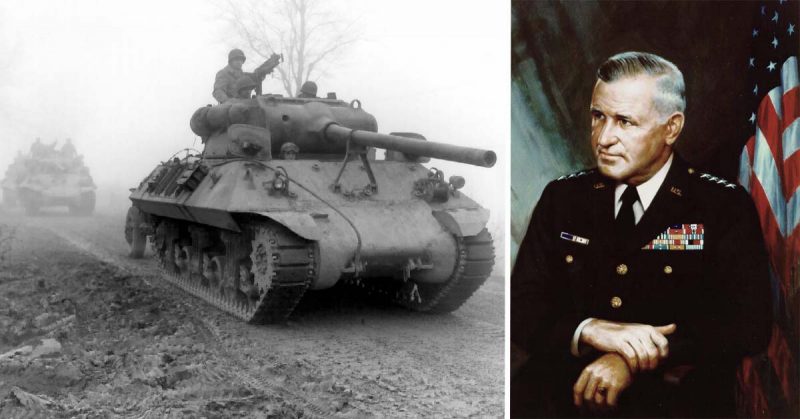In mid-December 1944, the 37th Tank Battalion, 4th Armored Division, led by Lt. Col. Creighton W. Abrams, was linked to the 87th Infantry Division and involved in probing operations along the Siegfried Line on the boundary with Lorraine. Plans were being prepared to withdraw the battalion for new equipment and reinforcements due to heavy combat. This had decreased tank strength to the company level; then the ‘fire call’ came when the Von Runstedt offensive began in the Ardennes.
Abrams, who presently commands the 63rd Heavy Tank Battalion, 1st Infantry Division, positioned at Mannheim, and his men did not realize it at the time, they were going to dash 100 miles north, fight their way through German forces around Bastogne and were the first element to reach U.S. Forces that were encircled there.
The armored trip from Lorraine started. Skies were overcast. At night, fatigued tank crews only saw blackout lights in the distance. In 48 hours, components of the 4th had made contact with the south edge of the 40-mile German intrusion.
Arlon was the place where the 4th assembled. On average, units covered 120 miles in 19 hours. Bastogne was ahead – north from Neufchateau along the highway.
Abrams’ unit and the 53rd Armored Division on Christmas Eve were commanded to swing to the left flank of the 4th to counter German forces which had advanced west of Bastogne.
The weather was clear the day before Christmas. The 3rd Army push to break through to Bastogne was 72-hours-old. Out of the clear sky came the RAF and Air Force to raise hell with German forces. And that they did.
Over Bigonville, secured by units of the German 5th Paratroop Division, came the Thunderbolts, dropping bombs only yards ahead of advancing U.S armor.
The town changed three times before the Germans withdrew. On Christmas morning at 2 a.m. Abrams’ unit and the 53rd had moved west, covering 30 miles to Bercheaux. They were ready to start a surprise attack. The Air Force came over again providing support.
The next day, Dec. 26, Abrams’ unit was positioned on a knoll looking down at a road leading to Assenois and Clochimont. Not far beyond, soldiers of the 101st Airborne Division were hunkered down in foxholes in a field covered with snow.
‘We’re going to get those people,’ said “Abe” from his turret. With an arm motion, he and the tank column wound their way down the hill towards Clochimon.
First Lt. Charles Boggess, a tanker in Abrams’ battalion in describing the battle related that beyond Assenois, the road travelled up a ridge through heavy woods. There were many Germans there, too. We went through fast, all guns firing, directly up that road to burst through before they had time to flee.
The 37th and 53rd rumbled through Assenois, knocking the hell out of Germans and houses. They rolled up the road and approximately two miles past Boggess came across an open field dotted with hundreds of colored parachutes that had been dropped by U.S. forces, Stars and Stripes reported.
After repeated calls to khaki-dressed figures in foxholes, a soldier appeared and introduced himself at 4:45 p.m. on December 26, 1944.
Within 30 minutes Abrams had advanced from the village and Brig. Gen. Anthony McAuliffe arrived at the outpost to offer greetings.”
